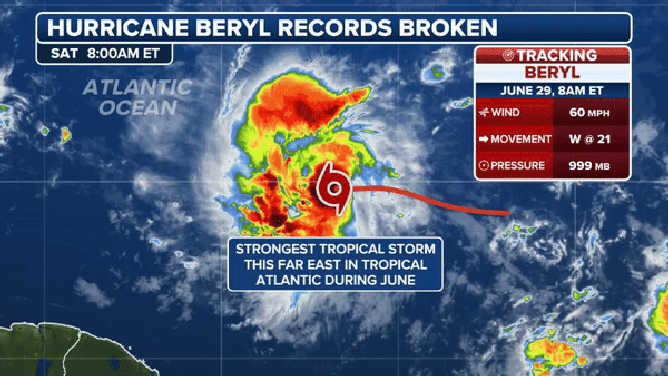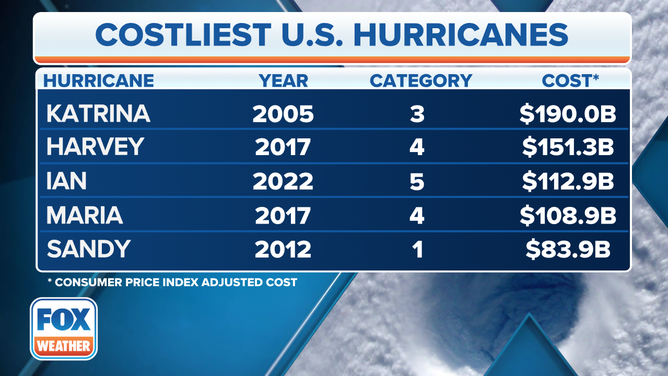Hurricane Beryl caused over $2.5 billion in wind damage in Texas, analytics company says
Hurricane Beryl first made landfall as a Category 4 storm in the Caribbean on July 1. A week later, Beryl hit Matagorda, Texas, as a Category 1 hurricane. More than 2.7 million power outages were reported around Houston and the Lone Star State following the storm.
Texas man survives Beryl's brunt
A Texas resident said he was trapped in his home after Beryl knocked over a large tree. Jordann Dwayne said the encounter was terrifying and there still is much work to be done to recover from the Category 1 hurricane.
HOUSTON – A private analytics company now believes insured losses in Texas from Hurricane Beryl’s winds will top $2.5 billion, making it the costliest storm in the Lone Star State since Hurricane Harvey in 2017.
CoreLogic, a global company specializing in property information and analytics, expects a range of wind damage totaling between $2.5 billion and $3.5 billion.
The estimated losses are from insured wind damage to residential, commercial, industrial and agricultural properties.
The research team said they were able to derive data by mapping out winds that topped 90 mph in some communities.
Beryl made landfall as a Category 1 hurricane near Matagorda, Texas, causing dozens of tornadoes and knocking out power to millions of residents.
Due to the cyclone being in an intensification stage at landfall, its sustained winds persisted longer than those of typical cyclones, leading to significant damage in Houston – the nation’s fourth-largest city.
WHY DO ISLANDS IMPACTED BY HURRICANE BERYL APPEAR BROWN IN SATELLITE IMAGERY?
Before the U.S. was impacted, countries including Grenada, St. Vincent and the Grenadines, Jamaica, the Cayman Islands and Mexico all reported varying degrees of damage.
CoreLogic estimates a billion dollars to $1.5 billion in insurable losses was produced in the Windward Islands, while Jamaica, the Cayman Islands. Mexico sustained less than a billion dollars in damage.
For several of the Windward Islands, Beryl was the worst storm to impact the region since Hurricane Emily in 2005.
"To see a major tropical cyclone east of the Caribbean in late June is almost unheard of," Howard Botts, Ph.D., CoreLogic’s chief scientist, said in a statement. "A Category 5 hurricane in early July has never been recorded."
The deaths of more than a dozen people in the Caribbean have been blamed on Beryl, with a similar-sized death toll in the U.S.

Hurricane Beryl broken records.
(FOX Weather)
2024 already at 2023 levels of estimated damage
The combined damage from both Alberto and Beryl in the U.S. has brought the season’s estimates close to the total damage caused by the strikes of Harold, Idalia and Ophelia in 2023.
Last season was the least impactful in nearly a decade for the continental U.S., with a combined damage estimate of about $4 billion.
"Hurricanes Idalia and Ian in 2023 and 2022 are good examples of why landfall location matters," said Jon Schneyer, CoreLogic’s director of catastrophe response stated. "Idalia, despite being a major hurricane at landfall, crossed the Florida coastline in the Big Bend region, a much less densely populated part of Florida. On the other hand, Hurricane Ian made landfall in southwest Florida over Cayo Costa near Fort Meyers. True, Ian was a stronger hurricane, but the difference in the estimated industry insured losses was large."
Damage during a typical season ranges from several billion dollars to around $20 billion but has reached as high as nearly $300 billion in 2017.
The record-breaking season featured three Category 4 hurricanes striking Florida, Texas and Puerto Rico.

A list of the five costliest hurricanes in U.S. history.
(FOX Weather)
